What is a powderpost beetle?
Powderpost beetles are a type of wood-boring insect that is about 1/8 to 1/4 inch long and are characterized by the fine, powdery dust that they produce as they bore into wood. They are often found in wood that has been improperly seasoned or stored, and they can cause significant damage to both hardwood and softwood materials.
There are several different species of powderpost beetles, including the lyctid powderpost beetle, the anobiid powderpost beetle, and the bostrichid powderpost beetle. They are commonly found in furniture, flooring, and other wood products, and they can be difficult to control once they become established in an infested piece of wood.

What do powderpost beetles look like?
Powderpost beetles are small insects that range in size from about 1/8 to 1/4 inch in length. They are typically reddish-brown to black in color and have a hard, shiny exoskeleton.
Some species of powderpost beetles have long, slender bodies, while others are more oval-shaped. The larvae of powderpost beetles are small, white, and worm-like, and they are responsible for the actual wood boring.
Powderpost beetles can be distinguished from other types of wood-boring insects by the fine, powdery dust that they produce as they bore into wood. This dust is made up of tiny, round, sawdust-like pellets that are a characteristic of powderpost beetle infestations.
Powderpost Beetles Vs. Carpet Beetles
Powderpost beetles and carpet beetles are both small insects that can cause damage to wood and other materials in homes and other buildings. However, there are some key differences between these two types of insects.
One of the main differences between powderpost beetles and carpet beetles is their size. Powderpost beetles are typically about 1/8 to 1/4 inch long, while carpet beetles are usually slightly smaller, ranging in size from about 1/16 to 1/8 inch in length.
Another difference between these two insects is the type of damage they cause. Powderpost beetles are wood-boring insects that tunnel into wood and leave behind a fine, powdery dust made up of small, round, sawdust-like pellets. This dust is a characteristic of powderpost beetle infestations. Carpet beetles, on the other hand, do not bore into wood. Instead, they feed on a variety of natural materials, including animal hides, feathers, and plant materials. They are known for causing damage to carpets, upholstery, and other household fabrics.
Finally, there are some differences in the appearance of these two insects. Powderpost beetles are reddish-brown to black in color and have a hard, shiny exoskeleton. Carpet beetles are more variable in appearance, with some species having a brown or black body covered in scales, and others having a more colorful patterned body.
Overall, it is important to correctly identify the type of insect you are dealing with in order to properly control and prevent further damage.

How To Get Rid Of Powderpost Beetles
It is generally a good idea to get rid of powderpost beetles if they are found in your home or other building. These insects can cause significant damage to wood and other materials, and they can be difficult to control once they become established in an infested piece of wood.
Powderpost beetles are most commonly found in wood that has been improperly seasoned or stored, so it is important to ensure that any wood used in construction or for furniture and other household items is properly seasoned and stored in a dry location. This can help to prevent infestations from occurring in the first place.
If you do find powderpost beetles in your home, there are several options for getting rid of them. One option is to use chemical insecticides, which can be applied to infested wood to kill the beetles. However, these products can be toxic to humans and pets, and they may not be effective in reaching all of the beetles if the infestation is extensive.
Another option is to use heat or cold treatment to kill the beetles. This can be done by either heating the infested wood to a high temperature or freezing it to a very low temperature. This method is generally considered to be more environmentally friendly and less toxic than chemical insecticides, but it may not be practical or feasible in all situations.
Ultimately, the best approach to getting rid of powderpost beetles will depend on the extent of the infestation and the specific characteristics of the infested materials. It may be necessary to consult with a pest control professional to determine the most appropriate course of action.
Powderpost Beetles: What To Do
In conclusion, powderpost beetles are small, wood-boring insects that can cause significant damage to both hardwood and softwood materials. They are commonly found in furniture, flooring, and other wood products, and they can be difficult to control once they become established in an infested piece of wood.
To prevent infestations, it is important to ensure that wood is properly seasoned and stored in a dry location. If an infestation does occur, there are several options for getting rid of powderpost beetles, including chemical insecticides, heat treatment, and cold treatment.
The best approach will depend on the specific characteristics of the infestation and the infested materials. It is important to correctly identify and properly control powderpost beetles to prevent further damage to wood and other materials in your home or building.
